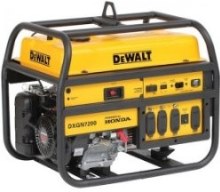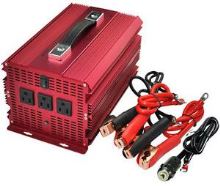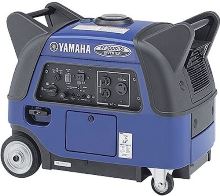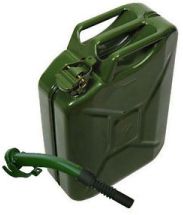For advice and tips on dealing with power outages see our blackout page in the potential disasters section, that deals with the subject.
- Options -
By installing a backup power supply it is possible to avoid most of the hardships that could result from power outages. Depending on your power requirements, there are 3 basic options to use for emergency backup power.
Generators
Generators are AC power supplies that use fuels like diesel, propane, and gasoline to run an engine, which powers a motor attached to an alternator that produces electricity. The motor must run at a constant rpm to produce the required voltage and frequency. If the engine's rpm fluctuates, so will the frequency (Hertz) of electrical output, while this is is ok for robust items such as fridges, hot plates and water pumps, it could damage sensitive electronics like computers. Generators excel when long extended runs and maximum power outage are required. Generators are available from the small 1000W gas/electric to 15kW diesels.
A few drawbacks of a generator are fuel efficiency, noise and quality of power (rpm fluctuation). Additionally if the engine of a generator is ran for short periods of time (45 min. or less), it can lead to carbon buildup on the critical engine components, shortening the life of your generator's engine.
Inverters
Inverters also supply AC power; a traditional inverter draws power from a fixed DC source, typically a fixed source like a battery bank or a solar panel, and uses electronic circuitry to "invert" the DC power into the AC power. Inverters only "drain" the amount of DC power required to power the device in use, think of it as a transfer. Inverters with the right battery bank are well suited for scenarios where short-term heavy loads, like a microwave, or long-term lighter loads like a television, only use the power required. Making inverters more efficient compared to generators. Another benefit is that they are virtually silent compared to generators and tend to surge well (typically twice their rated constant power output) compared to their fuel-based nemesis. Inverters come from 100W hand held inverters to portable 600W, and 600W to 3000W in hard-wired configurations.
Inverters are not the perfect solution since their energy supplies (batteries) are permanently mounted, hard to replenish, and have limited power storage. Additionally inverters typically provide less wattage.
With an investment in solar panels, an inverter could take the place of a generator. The long-term cost of ownership in a solar/battery/inverter system would be less than using a generator.
Inverter Generators
These generators output AC current like most traditional generators using a motor and fuel, but that current is then converted to DC, and then inverted back to clean AC power, by advanced electronic circuitry and high-tech magnets. That can maintain a single phase, pure sine wave at the required voltage and frequency. Because these types of generators are relatively new, they have been designed to incorporate many of the best features of both types of power supplies. The electronic circuitry gives them the quality of power of an invertor, and the conventional engine escapes the limitations of batteries.
These types of generators do not have the ability for extended run times or maximum wattage like a traditional generator, but technology is constantly improving. In addition some manufactures allow there generators to be run in tandem, effectively doubling the wattage output. Inverter generators come with a higher price than a similarly rated conventional unit.
Efficiency
The most effective scenario is to use the advantages advantage of both a generator and inverter in combination. Using the inverter to power anything it can, minus the heavy loads. Then when the batteries are depleted, or you require heavy loads run the generator, also allowing the battery charger to replenish the battery bank that gives the inverter its efficient power.
- Selection -
To help in choosing a backup power system, you will need to understand some basic terminology and formulas used in power and electronics discussions.
A formula to determine watts is: Amps x Volts = Watts
Watts - A unit of power. All appliances have a required wattage to operate.
Kilowatts (KW) - 1000 watts.
Surge Wattage - Appliances that use motors require extra watts for there initial start, this is called surge wattage.
Amps - Electrical flow rate.
Volts - Electrical pressure.
Sizing
When choosing the type of backup power supply to use, a primary factor will be the "load" requirements. Take a pen and paper and write down all appliances you feel will be necessary during an outage. Use the appliance nameplate or manual to find the wattage requirements for each appliance, add the total wattage of all appliances, including the starting power required by the largest motor and any others that will be started simultaneously to determine the load.
It's important to match the size of your generator to your electrical needs. An undersized generator won't last long and can destroy motors and other electrical equipment that require more current than the generator can deliver. For greatest efficiency and to prolong your generator's life, operate it at no more than 75 percent of its capacity.
Clink the link below to see estimates of wattage requirements for some appliances. The actual wattage required for your appliances may differ from those listed. Check the nameplate on the appliance to determine the actual wattage required.
Fuels and Fuel Storage
Depending on the severity of the power outage fuel availability could be a challenging issue. Gas stations require electricity to be able to pump gasoline or diesel fuel. During large scale outages, even if the station has power, the supply may not be able to meet the demand by consumers.
Fuel preservation can extend the shelf life of fuel by as much as a year by adding a conditioner to gas or diesel fuel. After adding a new batch of gas, be sure to run the engine long enough to draw the preserved gas into the carburetor. If gasoline is your choise for fuel a good pratice is to rotate your stored fuel by using it in your automobile and lawnmower before the fuel is more than six months old. And replace it with a fresh supply of fuel for the generator.
Delivery
There are two ways to deliver the power from your generator to where you want to use it:
Extension cords
The first option is extension cords while they are easy to use, they do have limitations. You have to run them from outside to indoors, and even then you can only energize items that have a plug-in connection like a freezer, refrigerator, or lamps. Items like the blower on your furnace, a household water pump or permanently installed lighting typically do not have a plug-in connection. If an extension cords are used, make sure they are rated to handle the load, typical household extension cords are fine for a couple of small appliances but create a fire hazard when used for heavier loads. Do not overload extension cords.
Transfer switch
The other option is to wire the generator directly to the homes electrical system. This is the only way to run equipment that can't be unplugged, such as furnace blowers and well pumps. If this option is utilized, you will be required to install a "Transfer Switch". These devices ensures that either your home is connected to the power grid or to your generator, but to protect utility workers never both at the same time.
- Operation Tips-
- To prevent carbon monoxide poisoning keep the generator outside of occupied spaces, and where exhaust fumes will drift away from windows and airvents.
- It is adviseable to protect the generator from adverse weather conditions, todays manufactures provide "generator houses" that are purposely designed to provide this protection.
- It is possible to be shocked by touching a wet power cord or plug while the generator is running. Shut the engine off before adjusting power connections.
- Do not refuel while the generator is running or when it is hot.
- If refueling at night, use a light source that will not ignite the fuel.
- Modern refrigerators and freezers can maintain temperatures if powered as little as 50% of the time, depending on ambient temperature, condition of the door seal, and how often the door is opened.It may not be necessary to run your generator full time.
- Any appliances or equipment powered by the generator should be turned off before shutting down the generator.
- Alternative Sources -
Renewable sources such as solar, hydroelectric, and wind generators are additional options for backup power. The merits of these alternatives deserve to be addressed in another topic.
- Security -
One should be aware, whether because of lights in the dark or the noise created by a generator, people will recgonize that you have power. If the power outage is minor this may not be an issue, but during an extended emergency or disaster, it could result in a strain on your resources or even unwanted attention.





